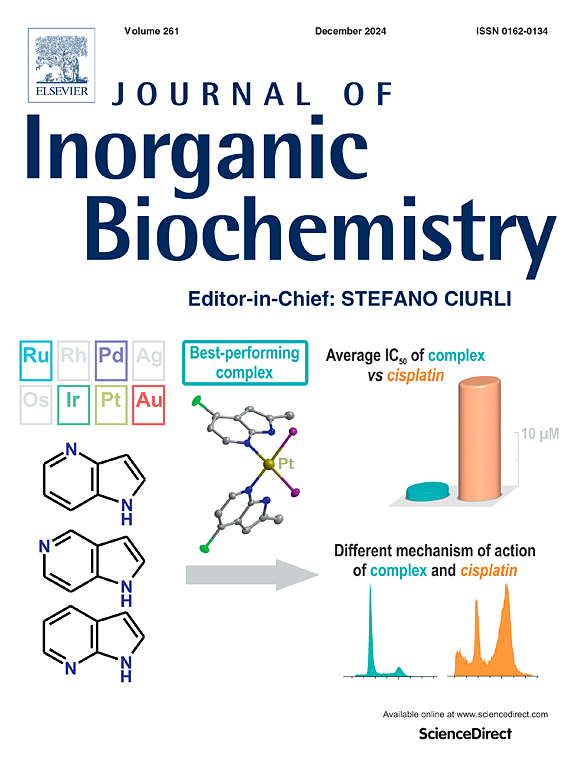An oral delivery approach for riboflavin-targeted platinum(II)-loaded lipid nanoparticles into alginate-gelatin matrices against 2D and 3D colorectal carcinoma models
IF 3.8
2区 化学
Q2 BIOCHEMISTRY & MOLECULAR BIOLOGY
引用次数: 0
Abstract
This study investigated the use of riboflavin-targeted Nanostructured Lipid Carriers (R-NLCs) to deliver a platinum-based anticancer drug [PtCl(8-O-quinolinate)(dmso)] (8-QO-Pt) to colorectal cancer cells. Three different R-8-QO-Pt-NLC formulations were prepared via hot-homogenization by ultrasonication method. The physicochemical characterizations of NLCs were analyzed by small- and wide-angle X-ray scattering (SAXS/WAXS) and fourier transformed infrared spectroscopy (FTIR). The cytotoxic effects and IC50 values of R-8-QO-Pt-NLC formulations were compared with those of the free 8-QO-Pt. Cellular uptake and apoptosis were evaluated towards HCT 116 cells in monolayer (2D). The liquid overlay technique was used to generate 3D multicellular tumor spheroids, MCTS. The anticancer and antimetastatic activities of the free 8-QO-Pt and R-8-QO-Pt-NLCs were determined in MCTS. The results revealed that R-8-QO-Pt-NLC exhibited greater cytotoxicity and lower IC50 values than free 8-QO-Pt in both 2D and 3D cell cultures. Furthermore, results showed that the volumes of the spheroids were reduced in response to increasing concentrations of R-8-QO-Pt-NLC, showing higher inhibition of cell migration in colorectal cancer spheroids at concentrations of 10.0, 15.0, and 25.0 μM than free 8-QO-Pt. To provide protection against gastric acid conditions, an additional drug delivery system based on alginate (Alg) and gelatin (Gel) beads for R-8-QO-Pt-NLC oral administration was developed. While free and R-NLC encapsulated 8-QO-Pt were practically inactivated at pH 1.2 and 37 °C, it was revealed that the Alg-Gel beads retain 5.7 times the initial activity of the R-8-QO-Pt-NLC. The findings of this research indicate that R-8-QO-Pt-NLC embedded in Alg-Gel beads are promising hydrogels for targeted colorectal delivery systems.

一种将核黄素靶向铂(II)负载脂质纳米颗粒口服递送到海藻酸-明胶基质中的方法,用于对抗2D和3D结直肠癌模型
本研究探讨了利用核黄素靶向的纳米结构脂质载体(R-NLCs)向结直肠癌细胞递送一种铂基抗癌药物[PtCl(8- o -喹啉酸酯)(dmso)] (8-QO-Pt)。采用超声热均质法制备了3种不同的R-8-QO-Pt-NLC配方。采用小角和广角x射线散射(SAXS/WAXS)和傅里叶变换红外光谱(FTIR)分析了NLCs的理化性质。比较了R-8-QO-Pt-NLC制剂与游离8-QO-Pt制剂的细胞毒作用和IC50值。对单层HCT 116细胞进行细胞摄取和凋亡评价(2D)。利用液体覆盖技术生成三维多细胞肿瘤球体(MCTS)。在MCTS中检测游离8-QO-Pt和r -8-QO-Pt nlcs的抗癌和抗转移活性。结果显示,R-8-QO-Pt-NLC在2D和3D细胞培养中均表现出比游离8-QO-Pt更高的细胞毒性和更低的IC50值。此外,结果表明,随着R-8-QO-Pt-NLC浓度的增加,球体的体积减小,在10.0、15.0和25.0 μM浓度下,球体对结直肠癌细胞迁移的抑制作用高于游离8-QO-Pt。为了提供对胃酸条件的保护,开发了一种基于海藻酸盐(Alg)和明胶(Gel)珠粒的额外药物递送系统,用于R-8-QO-Pt-NLC口服给药。当pH值为1.2和37℃时,游离的8-QO-Pt和R-NLC包封的8-QO-Pt几乎失活,结果表明,Alg-Gel珠保留的活性是R-8-QO-Pt-NLC初始活性的5.7倍。本研究结果表明,嵌入在al - gel微球中的R-8-QO-Pt-NLC是一种很有前途的靶向结肠直肠递送系统水凝胶。
本文章由计算机程序翻译,如有差异,请以英文原文为准。
求助全文
约1分钟内获得全文
求助全文
来源期刊

Journal of Inorganic Biochemistry
生物-生化与分子生物学
CiteScore
7.00
自引率
10.30%
发文量
336
审稿时长
41 days
期刊介绍:
The Journal of Inorganic Biochemistry is an established international forum for research in all aspects of Biological Inorganic Chemistry. Original papers of a high scientific level are published in the form of Articles (full length papers), Short Communications, Focused Reviews and Bioinorganic Methods. Topics include: the chemistry, structure and function of metalloenzymes; the interaction of inorganic ions and molecules with proteins and nucleic acids; the synthesis and properties of coordination complexes of biological interest including both structural and functional model systems; the function of metal- containing systems in the regulation of gene expression; the role of metals in medicine; the application of spectroscopic methods to determine the structure of metallobiomolecules; the preparation and characterization of metal-based biomaterials; and related systems. The emphasis of the Journal is on the structure and mechanism of action of metallobiomolecules.
 求助内容:
求助内容: 应助结果提醒方式:
应助结果提醒方式:


